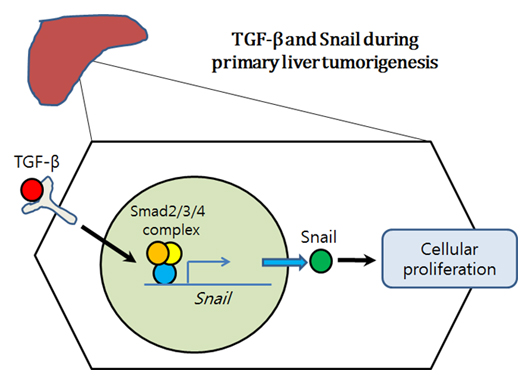New Pathway from Liver Cirrhosis to Liver Cancer Discovered
A research team led by Yonsei researchers has demonstrated that a certain activated signal promotes the incidence of liver cancer from the initial stage.
Patients with liver cirrhosis is a typical risk group of liver cancer. Fibrosis progresses by constant liver damage, and with the loss of liver functions a severe form of liver fibrosis is diagnosed as cirrhosis. Patients with liver cirrhosis have a very high chance of liver cancer.
TGF-β signaling is known as a major factor involved in liver cirrhosis, and active in most patients with cirrhosis. Ironically, TGF-β is known as a major tumor-suppressive signaling pathway that inhibits cell division and promotes apoptosis. Despite the tumor inhibitory role of TGF-β, it has long been a mystery for liver cancer researchers that cirrhotic patients with an elevated hepatic TGF-β signaling have a higher chance of liver cancer.
A research team led by Professor Weonsang Ro and Professor Kwang-Hyub Han of Yonsei University demonstrated that active TGF-β signal in the liver caused liver cancer by increasing the expression of Snail gene. The research team demonstrated that TGF-β signal is a necessary factor for tumorigenesis in the liver, and particularly, tumorigenic TGF-β signal is mediated by Snail, an EMT (Epithelial-Mesenchymal Transition) inducer.

Previously, it has been known that expression of EMT inducers increases in the later stage of tumorigenesis, or at the time of metastasis, to promote the tissue invasion and metastatic capabilities of cancer cells. On the contrary, the research team demonstrated that the expression of the EMT inducer, Snail is induced by TGF-β in the initial stage of tumorigenesis, which promotes cellular proliferation in the liver.
The research team produced various mouse models with liver cancer through a gene control technique. In the models, almost no liver cancer occurred when the Snail expression was inhibited or TGF-β signal pathway was blocked. Also, the research team demonstrated the core role of the Snail gene in tumorigenesis through TGF-β signal, by showing that liver cancer is actively generated by ectopic expression of Snail gene when TGF-β signal was artificially blocked.
Furthermore, the research team analyzed the pattern of gene expression in human liver tissues registered in the cancer database, and conducted an experiment of liver cancer tissue culture to confirm the applicability of the tumorigenic effects of TGF-β and Snail genes found in the mouse model to human liver cancer.
Professor Ro explained the significance of the research lies that “it shows how TGF-β signaling pathway induces tumorigenesis in the liver”. Also, he “expects future clinical application to prevent or treat liver cancer by targeting TGF-β or Snail genes.” The study was published on 2017 November issue of Gastroenterology, the foremost international journal in gastroenterology and hepatology.
Recommended Articles
Professor Hyuk-Jae Chang
Professor Sung-Joo Hwang